Green hydrogen was initially detected by Paracelsus in the early 1500s, but he did not pursue his experiments, which involved dissolving metals such as zinc in acid and seeing gas bubbles fizzing out. No fossil fuel was burnt to reduce the ore in the production of these metals, hence no fossil carbon dioxide was emitted.
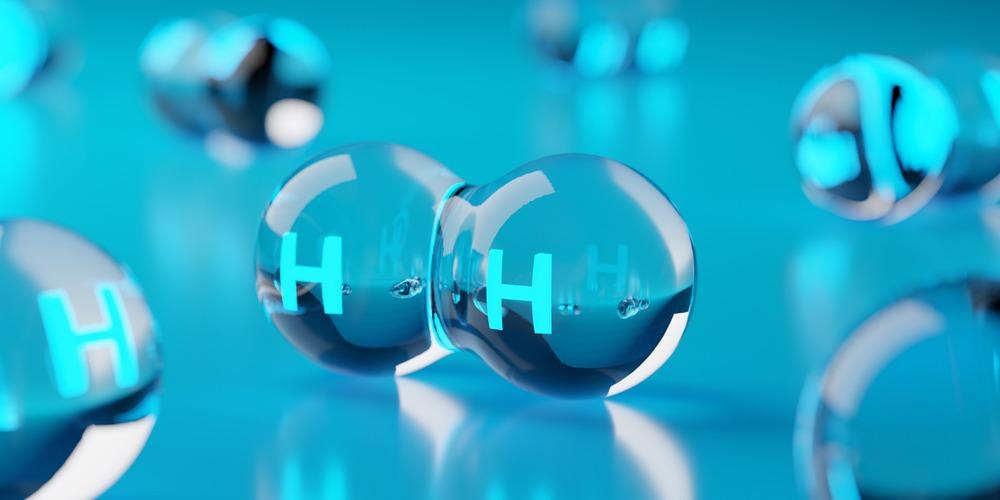
Image Credit: Shawn Hempel/Shutterstock.com
When Paracelsus put iron filings in dilute acid in 1671, Robert Boyle witnessed a similar reaction in the UK, before Henry Cavendish established in his 1766 papers that this green gas was a well-defined material with extraordinary qualities, creating water when burnt. In 1783, Lavoisier published a paper on the right theory of this reaction, naming the reactants hydrogen and oxygen.
Even after Nicholson and Carlisle described the electrolysis of water to make hydrogen and oxygen in 1800, the reaction was certainly grey (i.e., fossil), but it may have been green if the voltaic batteries used to supply the electric current were constructed from metals derived from charcoal.
As illustrated in Figure 1, the production of fossil-based hydrogen, also known as grey hydrogen, is slowly increasing over the world but must fall by 2100 if global warming is to be regulated.

Figure 1. Time chart of UK green hydrogen discovery, replacement by fossil grey hydrogen and re-emphasis in 2021. Image Credit: Kendall, 2022
Green Hydrogen in the United Kingdom
In 2021, the UK government recognized green hydrogen as a viable solution to the climate challenge, ranking it second behind wind energy but ahead of nuclear, zero-emission automobiles, and greener buildings on a priority list of ten possibilities.
Cities such as Birmingham have long recognized the need to minimize hazardous emissions from burning fossil fuels by establishing Clean Air Zones (CAZs). However, this was not included in the global warming response.
In July 2021, Birmingham introduced a green hydrogen refueling station and 20 hydrogen fuel cell battery electric vehicles (HFCBEVs) to replace diesel buses.
The Ballard PEMFC (Polymer Electrolyte Membrane Fuel Cell) bus, initially displayed in Vancouver in 1993, was met with opposition by proponents of pure battery electric vehicles (BEVs). The first hydrogen-fuel-cell bus arrived in London in 2003, but the fuel was not environmentally friendly.
Dr. K Kendall built the first green hydrogen station in the UK in 2008 to test five HFCBEV taxis on the University of Birmingham campus, demonstrating that this technology uses the same amount of energy as a lithium BEV but has twice the range of a combustion vehicle of equal weight and energy stored.
A proposal for the rise of green hydrogen in UK cities has been presented to address the country’s 35% CO2 emissions from fossil-fueled transportation, although the timeframe is unknown. For the UK to completely reject fossil hydrogen, another century of green hydrogen research and diffusion looks to be required.
Starting with the query, “What do you mean, green?” and moving on to the idea that fossil CO2 from transportation is the primary problem that green hydrogen can fix, this study, published in Clean Technologies and discussed in this article, covers the rise of green hydrogen in the United Kingdom.
The Clean Air Zone and the Climate Emergency in British cities were discussed within the paper. Early development in green hydrogen in transportation is discussed, along with a timeline for implementing change in Birmingham, then throughout the United Kingdom. Finally, the future of green hydrogen in the United Kingdom is discussed.
Methodology
This study demonstrates how researchers might take a methodical approach by eliminating fossil diesel fuel, which is used in almost every element of daily life, including food, steel, grid energy, heating, and transportation (Table 1).
Table 1. UK sectors contributing to fossil CO2 emissions, ignoring 10% CO2 embodied in imported goods. Source: Kendall, 2022
| SECTOR |
% FOSSIL CO2 |
| Agriculture |
8 |
| Industry and Waste |
14 |
| Electrical Grid |
18 |
| Heating Buildings |
25 |
| Transport |
35 |
Figure 2 depicts the first of these Zero-Emission Vehicles (ZEVs) to arrive at the CAZ, with a total of 124 more on the way.
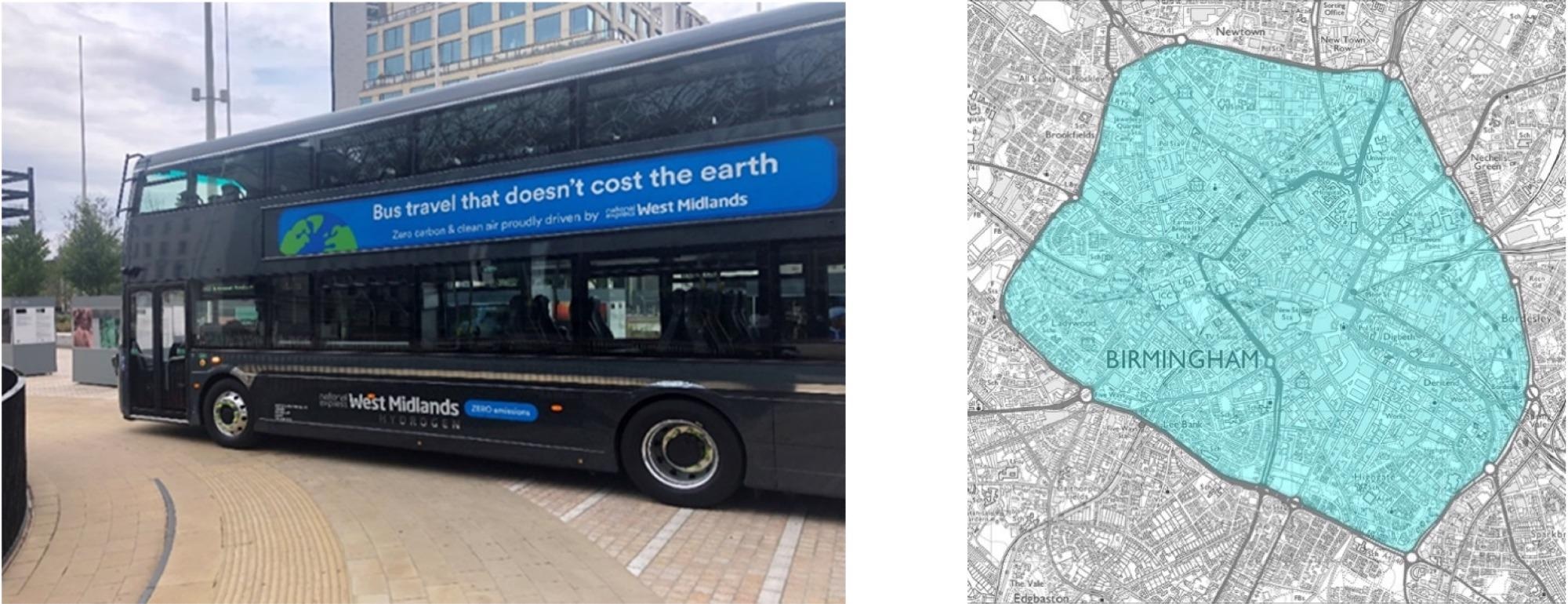
Figure 2. Left: Hydrogen fuel cell battery electric bus arriving in Birmingham July 2021; Right: Clean Air Zone (CAZ) map. Image Credit: Kendall, 2022
To refill the Microcab cars, the gas was compressed to 400 pressure using an Air Products dispenser (Figure 3).

Figure 3. Left: First UK green hydrogen station opened in 2008 at the University of Birmingham by K Kendall; Right: five hydrogen-fuel-cell-battery-electric-Microcab cars tested on campus over 5 years. Image Credit: Kendall, 2022
Standard-drive cycles were completed and the energy consumption per km was recorded in MJ, as shown in Figure 4, to compare the five Microcabs’ enhanced energy performance to 3800 different types of petrol automobiles used in China from 2000 to 2010.
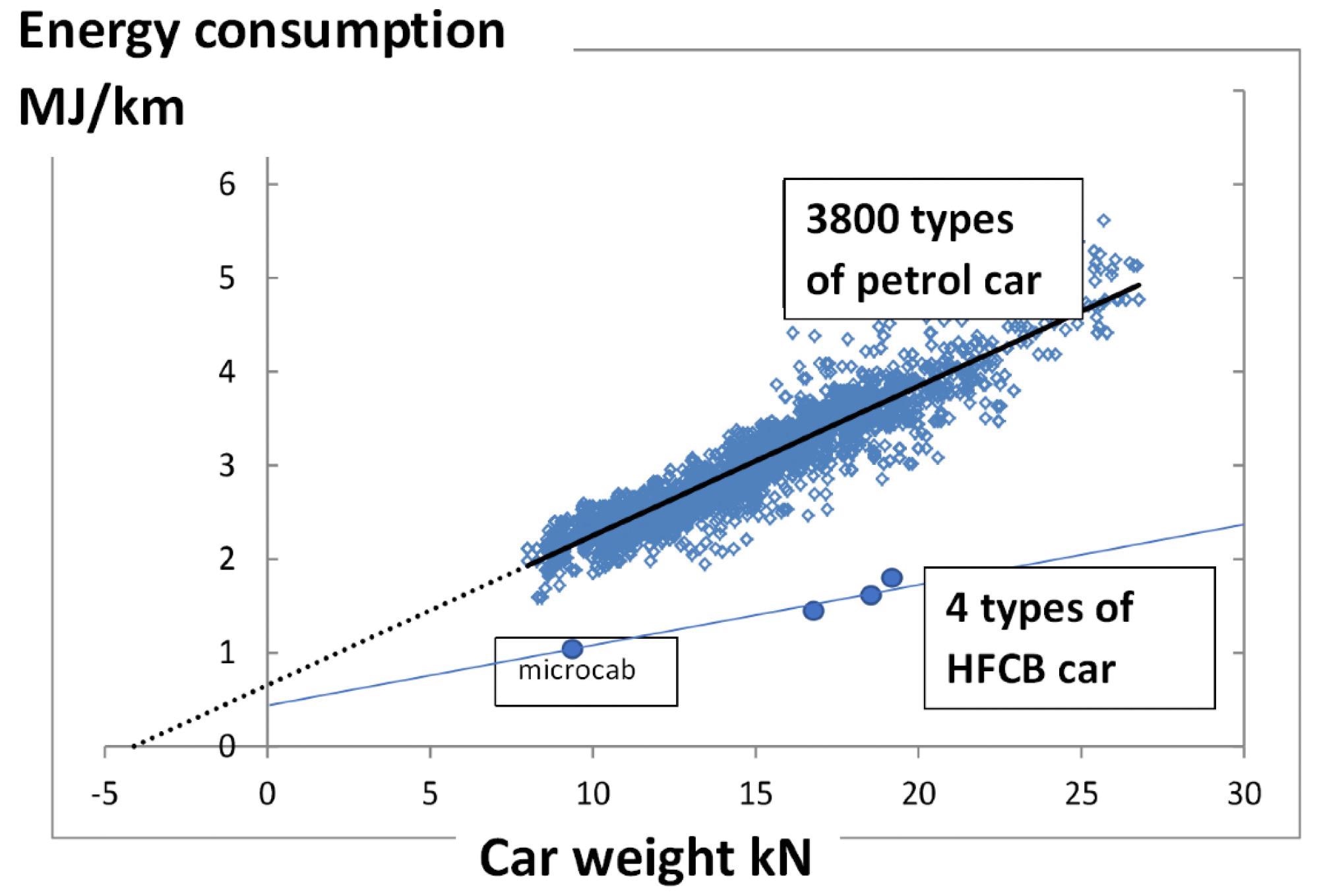
Figure 4. The energy consumption in MJ/km of 3800 types of gasoline combustion cars in China against vehicle weight in kN, showing the Coulomb friction law fit, for a comparison with 4 HFCB cars in pre-production. Image Credit: Kendall, 2022
In comparison to the significantly higher amount of fossil hydrogen generated on petrochemical refinery sites, Figure 5 demonstrates how green hydrogen generation has been expanding globally.
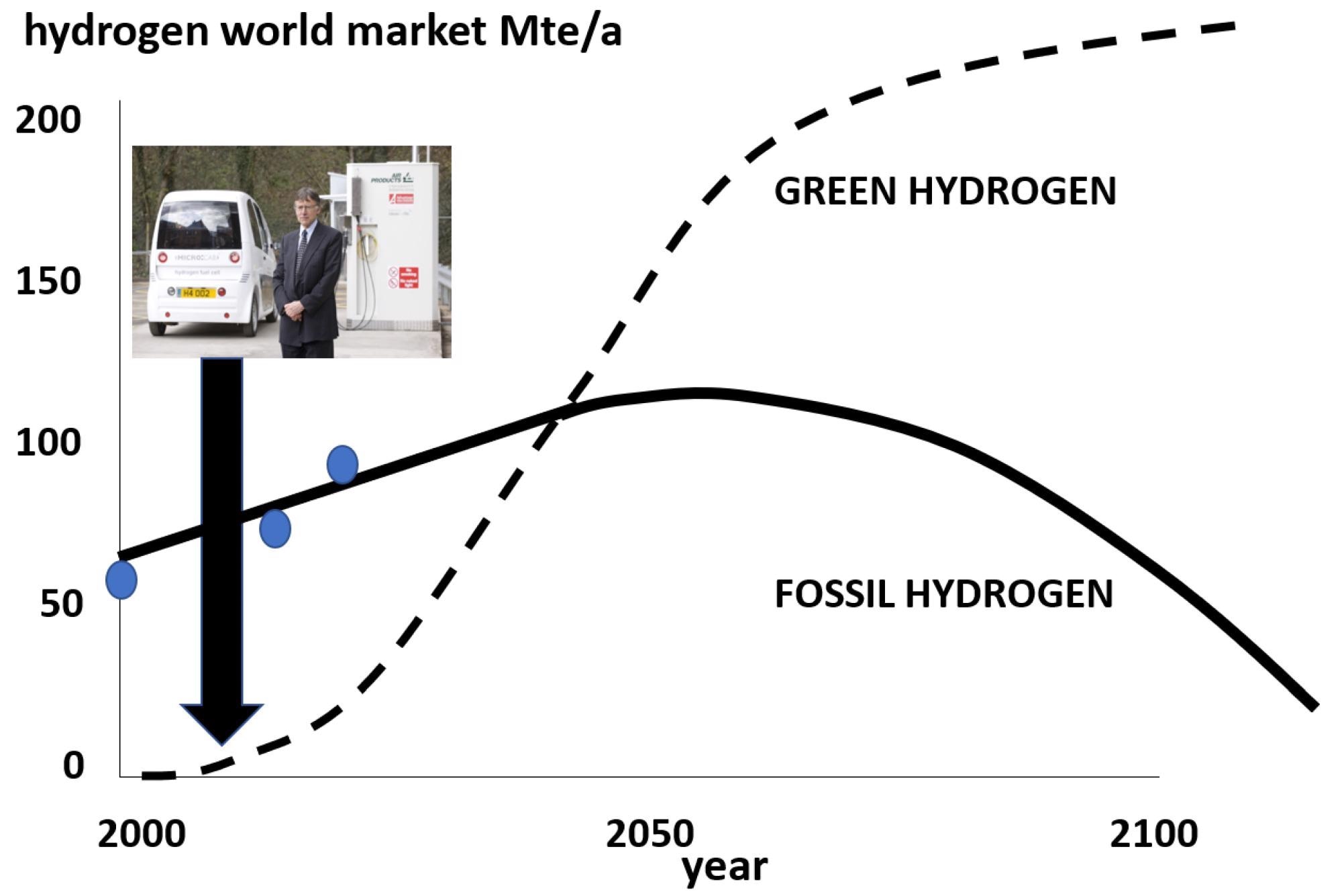
Figure 5. Schematic picture of global hydrogen production from 2000 onwards. The accepted numbers for 2022 are shown as circular points, approximately fitting the line showing fossil hydrogen still increasing from 70 Mte/a to 100 Mte/a by 2050, followed by a gradual decline as green hydrogen overtakes it to magnify the whole hydrogen market by a large factor as new applications appear, ultimately reaching hundreds of Mte/a (estimated from UK government predictions). Image Credit: Kendall, 2022
The Microcab taxi/van (Figure 6) was designed by Jon Jostins in 2004 and has been further developed and enhanced since 2012 when the EU SWARM project was launched to build a hydrogen highway between Birmingham and Germany.
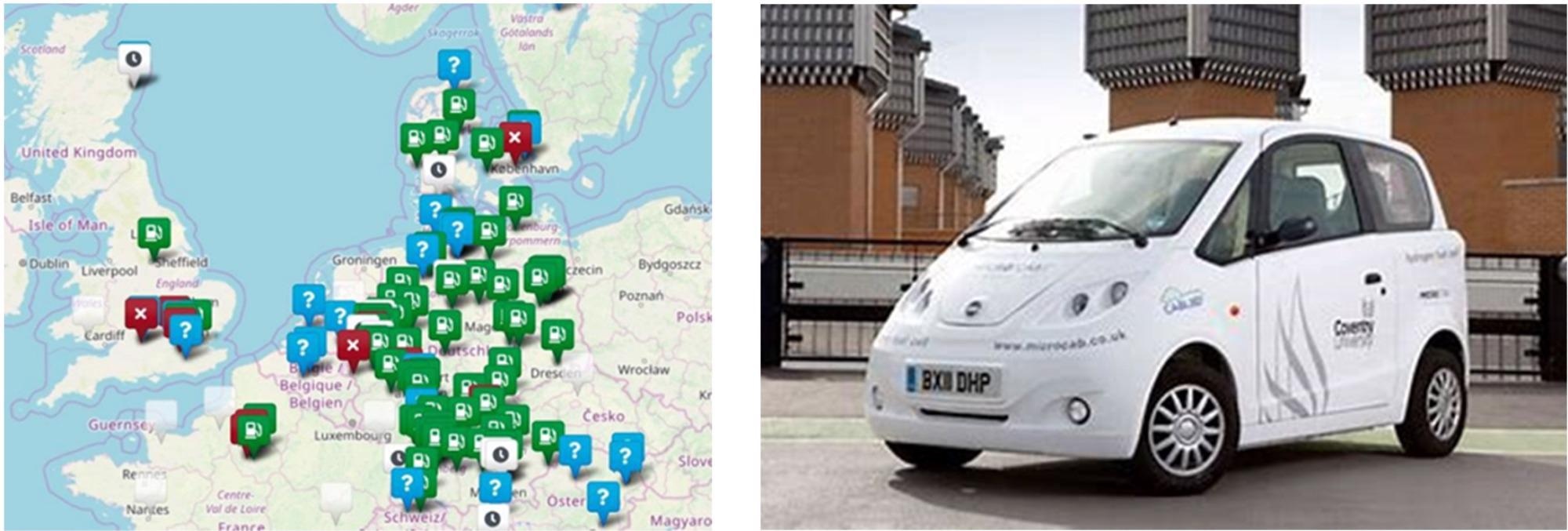
Figure 6. Left: 2021 hydrogen stations in the UK compared to the EU, showing that the UK has only 12 stations in 2021 with only 4 working, which is well behind Germany with 93; Right: Microcab HFCBEV taxi/van built in Birmingham. Image Credit: Kendall, 2022
Figure 7 depicts two examples. A wind turbine in Rotherham generates green power, which is used to electrolyze water to make green hydrogen. The Birmingham station, on the other hand, gets its energy from the electrical grid and claims to be environmentally friendly since green energy intake to the system is assessed and allotted to ITM on paper.
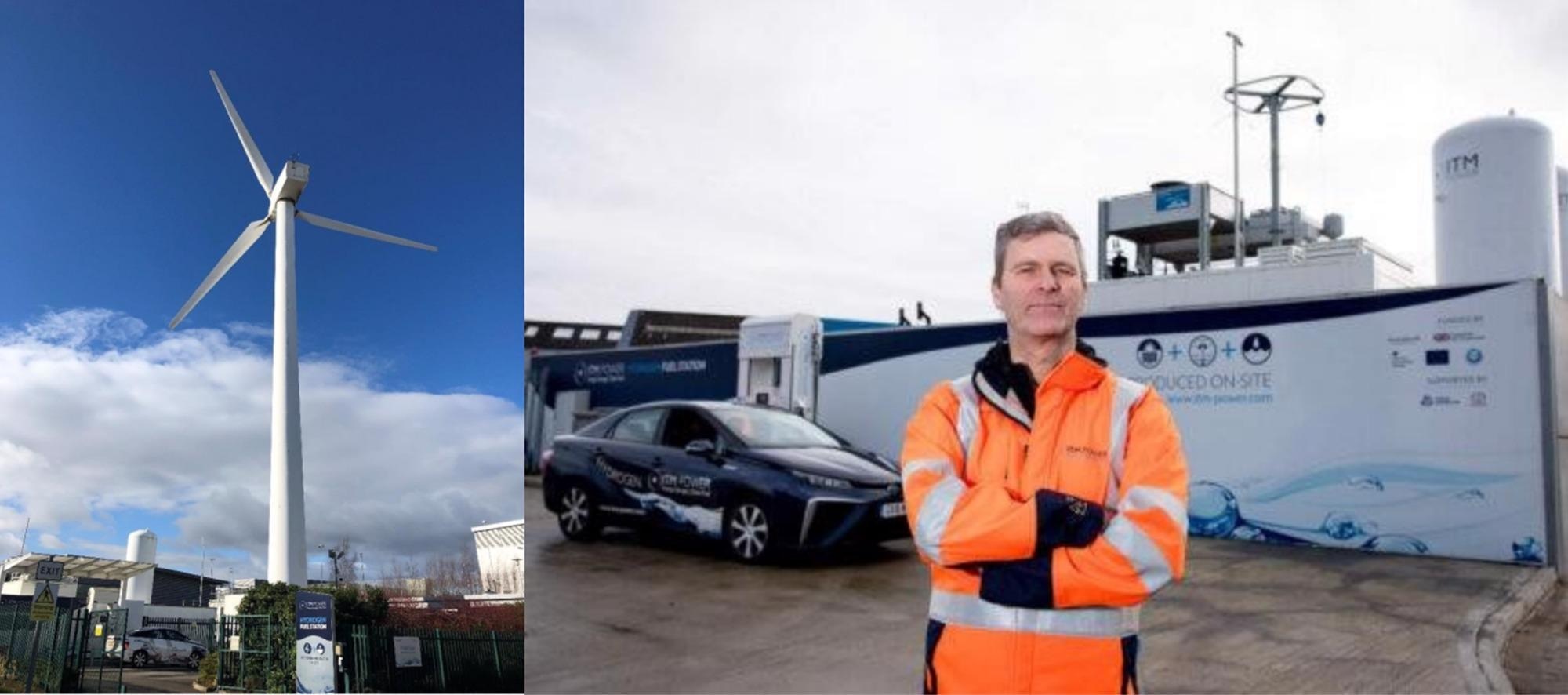
Figure 7. Left: ITM Rotherham hydrogen station powered by wind turbine; Right: Birmingham ITM hydrogen station with Duncan Yellen ITM motive CEO. Image Credit: Kendall, 2022
The Future of Green Hydrogen in the United Kingdom
The replacement of more than 1 Mte/a of fossil hydrogen now generated in petrochemical facilities is the UK’s top priority in terms of green hydrogen. Buses and trucks, for example, should be replaced with hydrogen fuel cell battery electric vehicles (HFCBEVs). All such combustion cars should be replaced, preventing many deaths and diseases in cities while also cutting 35% of UK fossil CO2 emissions.
Battery electric vehicle (BEV) registrations in the United Kingdom attained over 1% penetration in 2021, however, hydrogen fuel cell battery electric vehicle (HFCBEV) registrations are still 1000 times lower. Birmingham’s BEV and green hydrogen car populations are predicted to reach 100,000 by 2030, significantly lowering CO2 and other emissions.
Clean Air Zones (CAZs) are critical because they may stimulate the switch to green hydrogen and demonstrate to residents that this new fuel would improve the country’s quality of life. To accomplish this significant transition, almost 1 Mte/a of UK green hydrogen (4 GW continuous generation) would be required, starting from near zero in 2020.
Green hydrogen is also being used in buildings to reduce natural gas use and in industrial locations where local heat and power generation may distribute energy more effectively than the electrical grid. These developments will necessitate an additional 4 GW of continuous output, primarily from wind turbines, whose population is expected to increase by an order of magnitude by 2050, while salt-cavern storage will rapidly expand from the three tiny sites utilized to date.
Journal Reference:
Kendall, K. (2022) Green Hydrogen in the UK: Progress and Prospects. Clean Technologies, 4(2), pp.345-355. Available Online: https://www.mdpi.com/2571-8797/4/2/20/htm.
References and Further Reading
- Kendall, M., et al. (2021) Hystory: The Story of Hydrogen; Adelan: Birmingham, UK.
- Rigden, J S (2003) Hydrogen: The Essential Element. American Journal of Physics, 71(2), p. 189. doi.org/10.1119/1.1522705.
- Boyle, R (1672) Tracts Written by the Honourable Robert Boyle Containing New Experiments, Touching the Relation Betwixt Flame and Air In: Davis Publications: London, UK.
- Cavendish, H (1766) Three Papers, Containing Experiments on Factitious Air. In: Philosophical Transactions of the Royal Society the University Press: London, UK, 1766; 56, pp. 141–184. https://doi.org/10.1098/rstl.1766.0019
- Brightling, J (2014) A Long History in Steam Reforming at Billingham. Nitrogen+ Syngas, 327, p. 46. Available at: https://fdocuments.net/document/a-long-history-in-steam-reforming-at-billingham.html
- UK Hydrogen Strategy, Department for Business, Energy & Industrial Strategy. 2021; p. 121. ISBN 978-1-5286-2670-5. Available at: https://assets.publishing.service.gov.uk/government/uploads/system/uploads/attachment_data/file/1011283/UK-Hydrogen-Strategy_web.pdf (Accessed 20 February 2022).
- Breathalyser. Wikipedia. Available at: https://en.wikipedia.org/wiki/Breathalyzer
- Stuart, H A & Binney, C R (2022) Improvements in Engines Operated by the Explosion of Mixtures of Combustible Vapour or Gas and Air. Patent No 7146, May 1890. Available at: https://www.wikiwand.com/en/Herbert_Akroyd_Stuart.
- Hawke, D (2020) Gas Network Innovation Competition. In: Cadent Fourth Project Progress Report (PPR); HyDeploy, Keele University: Newcastle Under Lyme, UK.
- BEIS Consultation on UK Low Carbon Hydrogen Standard 1921, Designing a UK Low Carbon Hydrogen Standard-GOV.UK (2022). Available at: http://www.gov.uk.
- King, J (2007) The King Review of Low Carbon Cars; Part I /Part II. In: HM Treasury: London, UK.
- Khan, S (2021) Mayor of London, Central London Ultra Low Emission Zone 2020 Report. In: Greater London Authority: London, UK.
- Available at: https://www.statista.com/statistics/616220/diesel-fuel-stock-uk/#:~:text=Diesel%20vehicle%20fuel%20stock%20in%20the%20United%20Kingdom,figures%20increased%20by%20roughly%201.4%20million%20metric%20tons (Accessed 20 February 2022).
- Kendall, K., et al. (2011) Hydrogen fuel cell hybrid vehicles for Birmingham campus. Journal of Power Sources, 196(1), pp. 325–330. doi.org/10.1016/j.jpowsour.2009.12.012.
- Kendall, K., et al. (2013) Application of Coulomb’s friction law to define energy consumption of new drive-trains. In: IET Hybrid and Electric Vehicles Conference 2013 (HEVC 2013), London, UK, 6–7 November 2013. Available at: https://digital-library.theiet.org/content/conferences/10.1049/cp.2013.1894
- Available at: https://www.h2-view.com/story/air-liquide-to-lead-200mw-flagship-green-hydrogen.
- Available at: https://www.iea.org/reports/global-hydrogen-review-2021 (Accessed 20 February 2022).
- Liu, Z., et al. (2019) China progress on renewable energy vehicles: Fuel cells, hydrogen and battery hybrid vehicles. Energies, 12(1), p. 54. doi.org/10.3390/en12010054.
- H2.LIVE: Hydrogen Stations in Germany & Europe (2022). Available at: https://h2.live/en
- Hydrogen Shares Could Boom as Europe Pivots from Russian Natural Gas (2022). Available at: http://fool.co.uk